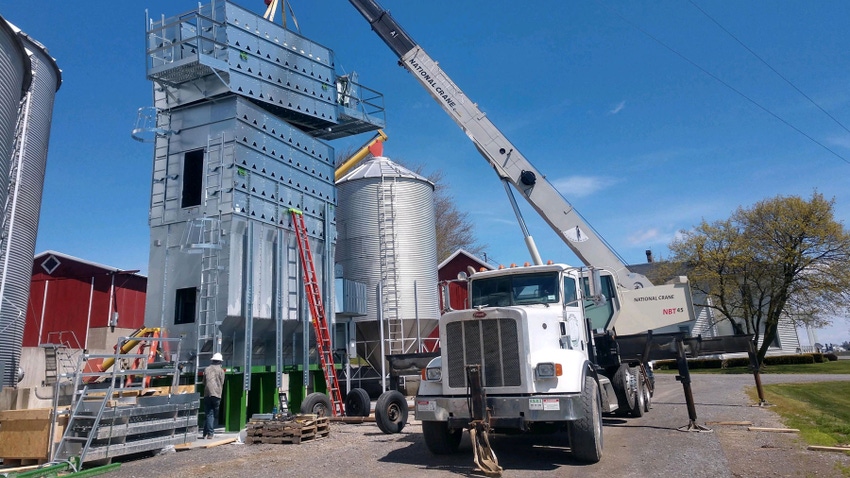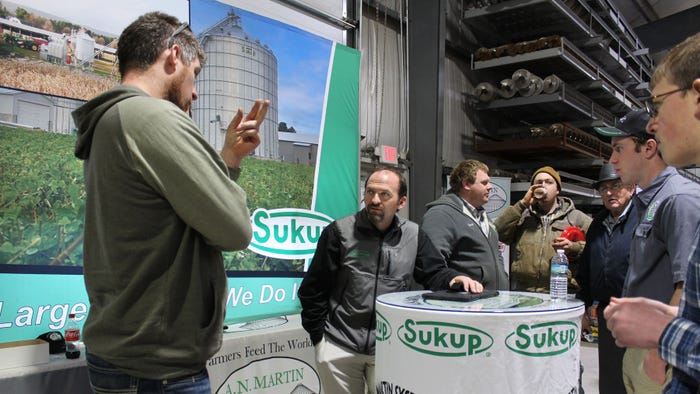June 7, 2023

As Lilyea Farms LLC has experienced growth, operator Mike Lilyea has had to improve his farm’s facilities not only for himself, but for other farmers, too.
The farm, in Penn Yan, N.Y., grows 1,500 acres of corn, soybeans and wheat, and dries and stores grain for other farms.
A new Sukup Mixed Flow dryer and elevator were installed in 2020, and two new large storage bins were put up in recent years — one in 2014 and one just last year.
“Lydell [Martin] worked with us closely as to what we needed, what’s available and pricing,” Lilyea says. “A.N. Martin is a good group to work with.”
One of the newer bins holds 93,000 bushels, a welcome addition given the farm was running out of grain storage capacity.
“I usually am pretty particular on fine parts, and I want things done the way I want them done,” Lilyea says. “They [A.N. Martin] were good at making sure that happens. There’s always hiccups with major projects, but we got them resolved. There was timing and getting parts and pieces together.”
Supply chain issues made acquiring parts challenging, and this lengthened the project’s timeline. But the system was completed in time for last year’s wheat harvest.
Lilyea — who works with his son, Garrett, and his father, Gary — says he relied on A.N. Martin to plan the system’s layout for maximum efficiency. Sometimes the recommendations surprised him, but he says he trusted Lydell Martin and his crew, and he’s happy with the results.
“You’ve got to have a good crew; that is your support,” Lilyea says. “If it’s not guys like the ones they sent to us, there are things that won’t go as smooth. We’re expanding and drying more. It’s a lot bigger, and we took a big jump. It was like learning all over. The A.N. crew was out here explaining it. When we had problems, they had engineers here explaining it. You won’t get that from other companies.”
What size dryer do you need?
How do you know what size grain dryer you need? Lydell Martin, technician and consultant for A.N. Martin, says there are two ways to calculate this: location and farm output of bushels combined per season.

TALKING GRAIN SYSTEMS: Lydell Martin of A.N. Martin Grain Systems discusses grain systems with attendees of an A.N. Martin open house in Clyde, N.Y., earlier this year. How do you know what size grain dryer you need? Martin says there are two ways to calculate this: location and farm output of bushels combined per season.
“I’m going to try to size his grain dryer so he can harvest his crop and run it through the dryer within three weeks without it running 24/7,” he says. “If it’s 19 hours a day, six days a week, it can take three weeks.”
He adds that you should allow for a few “down” days during combining.
Commercial operations will need a larger wet bin and a moderately sized dryer, he says.
The minimum wet bin size should accommodate the dryer running for 14 hours. Look at the cubic feet of air per minute (cfm) per bushel. Slower drying equals better quality.
Martin says to aim for 40 cfm at 220 degrees F for top quality.
Changing a single sensor won’t make the dryer more efficient, he says. Changing something mechanically is the only way to do this.
Higher-horsepower fans will dry grain faster by only 10%, Martin says, not the 50% many manufacturers claim.
He says farms harvesting 20,000 or more bushels should go for a continuous-flow dryer.
A growing business
What began in 1979 as Allen Martin’s “side hustle” of moving and building grain bins in Pennsylvania has grown to become A.N. Martin Grain Systems, with locations in Clyde and Pavilion, N.Y.
In 1986, Allen Martin and his brothers moved to New York to start a dairy farm. According to the company’s website, he kept receiving calls from grain bin customers for maintenance and upgrade requests. Martin saw an opportunity to launch a whole new business.
By 1990, the family transitioned out of the dairy business. The Martins converted a dairy barn into a warehouse for grain handling equipment parts.
The Martins have added more buildings and a second location in Pavilion in 2011. The business installs, builds and services grain handling equipment and has become one of the largest such businesses in the Northeast.
Currently, Allen Martin’s son, Jason, operates the business as president. About 90% of A.N. Martin’s equipment comes from other companies; the remainder, the company builds.
“Normally, it’s components like auger flighting or elevator sections, for example,” Lydell Martin says. “Or if a part is rusted out or if someone needs to extend it, we can do that. We don’t manufacture much whole goods.”
One exception are the spinach harvesters the company builds as a side business. The company also builds grain equipment as a subcontractor.
One of A.N. Martin’s top suppliers is Sukup Manufacturing. The two companies have become close enough over the years that A.N. Martin works with Sukup to develop new options and uses of technology in its drying systems.
A.N. Martin typically builds and installs equipment within a 20-state radius, but it has done builds as far away as California.
“For that long-distance stuff, we did not send equipment or tools,” Lydell Martin says. “Our crews flew out there and did labor for other dealers. We’ve gone as far as Illinois with our equipment.”
The company built an expanded storage facility at the Port of Oswego that increased grain handling capacity from 58,000 metric tons to 308,000 metric tons.
“Our largest project was 1.2-million-bushel capacity,” he says. “We have the capability to go bigger but we have not seen the need. The majority of our bins in this area are closer to 50,000-bushel builds.”
Expected payback?
In the past two years, Martin says he has seen many more farms roasting and processing their own high-oleic soybeans, and grinding cornmeal.
Farmers are trying to cut costs, he says, as they can make high-quality feed and save 20 to 30 cents per cow per day. On a 1,000-cow dairy, that’s about $75,000 in annual savings.
“If you have 50 to 100 cows, that won’t help. If a farm has 1,000 cows, the farmer can start investing,” he says.
Most farmers see a return on investment anywhere between six months and a few years, depending on quality of feed they have and other factors. A system that could accommodate a 1,000-head dairy could cost a couple of hundred thousand dollars, but many variables are at play, such as the site and infrastructure present.
“I’ve done soybean facilities that cost $70,000 — and some $200,000,” Lydell Martin says. “The average farm is $200,000 and it will do both soybean and corn meal. We highly recommend the system that does both. Half the infrastructure can be used for both.”
Martin stresses that estimates on return on investment and installation are just that — estimates.
Sergeant writes from central New York.
About the Author(s)
You May Also Like




